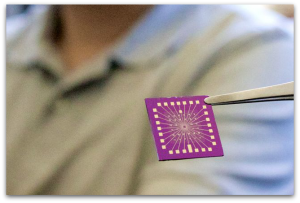 A tiny chip may be the answer to the wide-spread utilization of fuel cells.
A tiny chip may be the answer to the wide-spread utilization of fuel cells.
A team of researchers from UCLA have developed a nanoelectronic chip that can accurately analyze the chemical reactions that allow fuels cells and batteries to function. The new chip effectively evaluates at the nano level how nanocatalysts convert chemical reactions into electricity.
New Insights About Fuel Cells
Essentially, the chip scales down spectroscopy—doing what a large laboratory would typically do, only more effectively and with the ability to collect new data.
This from UCLA:
Being able to analyze these reactions with increased accuracy, heightened sensitivity and greater cost-effectiveness will vastly improve scientists’ understanding of nanocatalysts, which will enable the development of new environmentally friendly fuel cells that are more efficient, more durable and less expensive to produce. Eventually, those new fuel cells could be used to power vehicles that run on hydrogen, the 10th most abundant element on Earth, and give off water as exhaust.
The research was led by Xiangfeng Duan, a published ECS author.
Fuel Cells and the Future
To improve fuel cells and hydrogen batteries—which will help define the future of the renewable energy grid—researchers must better understand the chemical reactions that occur to make them work. With this comes the desire to better understand nanocatalysts, the facilitators of electrochemical interactions with materials.
“Normally, spectroscopy is used for this kind of analysis,” Duan said. “But conventional techniques are difficult for in situ, or active, electrochemical studies. On-chip electrical transport measurements enable us to directly probe the electrochemical surfaces of metallic nanocatalysts while they are in action. This has allowed us to access a completely new set of information about electrocatalysts.”
If the data collected allows researchers to better understand nanocatalysts, they could in turn develop improved batteries and fuel cells.
“Fuel cells are becoming more widely recognized as a powerful future technology, and nanocatalysts are the most expensive component, inhibiting widespread adoption of the technology. This new technique will help us understand and develop better and cheaper catalysts, allowing the technology to reach its full potential,” Duan said.
[Image: UCLA]

